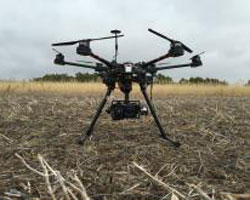Things to know before you fly a small unmanned aircraft system
Free UAS resource covers regulations, potential applications and more.
 Released: Jan. 26, 2016
Released: Jan. 26, 2016
MANHATTAN, Kan. – Some people buy them for photography. Some prefer them for racing. Still, others just want a view of the world that until recently wasn’t available to most of us, but small unmanned aircraft systems, or “drones,” come with responsibilities – and a whole lot of potential to aid public safety, food production and more.
Small UAS have been around about as long as aviation itself, according to Kansas State University scientists Brian McCornack and Kurt Carraway. The small, fixed- or rotary-winged systems have been used by the military for years, but technological advances and affordability have sparked an interest for recreational and commercial use. The recent wave of popularity has also heightened concerns about safe operation of the systems.
Some aircrafts are so small they weigh less than a pound and can fit in the palm of your hand, said McCornack, an entomologist based at K-State’s Manhattan campus. He and Carraway, UAS program manager at Kansas State Polytechnic in Salina, have produced a publication, “What You Should Know About Small Unmanned Aircraft Systems (UAS),” available free online or by visiting a county or district K-State Research and Extension office.
Recent innovations in UAS technology can provide real benefits to how we grow our food, inspect buildings and bridges, observe certain public safety situations and monitor water quality, McCornack said.
Under current Federal Aviation Administration rules, a certificate of authorization is required to operate a small UAS in national airspace for commercial or public entities. It is important to know the rules before you fly to keep the airspace safe.
More information about UAS regulations, potential uses and descriptions of commonly used terminology when it comes to small UAS is available in the publication.
-30-
K‑State Research and Extension is a short name for the Kansas State University Agricultural Experiment Station and Cooperative Extension Service, a program designed to generate and distribute useful knowledge for the well‑being of Kansans. Supported by county, state, federal and private funds, the program has county Extension offices, experiment fields, area Extension offices and regional research centers statewide. Its headquarters is on the K‑State campus in Manhattan.
Story by:
Mary Lou Peter
mlpeter@ksu.edu
K-State Research and Extension
For more information:
Brian McCornack – mccornac@ksu.edu or 785-532-4729
Kurt Carraway – kcarraway@ksu.edu or 785-826-2624
